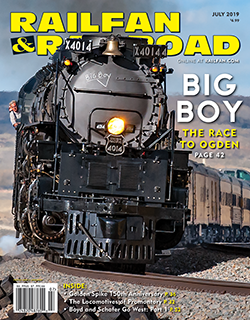 In May 2019, much of the nation’s attention turned west, to various celebrations marking the 150th anniversary of the first transcontinental railway in the U.S. There were articles and books, museum exhibits, and reenactments. The most spectacular celebration, however, came from Union Pacific, the sole surviving railroad from that original line. To mark the occasion, UP debuted the newest member of its heritage steam fleet, locomotive 4014. Built in 1941, the 4014 is one of the so-called “Big Boys,” the largest class of steam locomotives ever to operate. (You can read more about its amazing comeback story starting on page 42.)
In May 2019, much of the nation’s attention turned west, to various celebrations marking the 150th anniversary of the first transcontinental railway in the U.S. There were articles and books, museum exhibits, and reenactments. The most spectacular celebration, however, came from Union Pacific, the sole surviving railroad from that original line. To mark the occasion, UP debuted the newest member of its heritage steam fleet, locomotive 4014. Built in 1941, the 4014 is one of the so-called “Big Boys,” the largest class of steam locomotives ever to operate. (You can read more about its amazing comeback story starting on page 42.)
While the 4014 is impressive, just seven years after its introduction UP was contemplating replacing it and its kin.
The first would-be successor was the General Electric 101, a massive locomotive constructed to test a gas turbine mated to an electric generator and motors. Known as a Gas Turbine Electric Locomotive (GTEL), the GE 101 was quickly accepted, renumbered as the 50, and put into service in Wyoming. UP found the 50 to have teething problems, but it also proved the promise of turbine technology. As a result, from 1952 to 1961, UP took delivery of 55 Alco-GE turbines. They were enormous and loud, sounding constantly like a slightly muffled jet plane about to take off. And though they were powerful, the turbines were also thirsty, requiring so much fuel that they operated with converted steam locomotive tenders to keep them satiated.
Yet, within a few years of the last turbine delivery, the UP was again planning for replacements. The company wanted conventional diesels, but on a scale never before seen, and several builders responded. In 1963, General Motors’ Electro-Motive Division offered the cabless DD35, essentially two diesels in one body on one frame, to be paired with conventional diesels. Next, in 1964, Alco offered up the Century 855, following the same formula but with a cab, while at almost the same time Alco’s former partner, General Electric, offered up the comparable U50. The former was a dud, with only demo units built, but many U50s were delivered to UP. Next came GM-EMD’s cab-equipped DD35A (1965), the even larger DDA40X (1969), and GE’s U50C (also starting in 1969).
In almost every case, Union Pacific was the only purchaser of these large locomotives, and they became synonymous with UP itself. The recessions of the mid-1970s and early 1980s, however, largely sidelined most of these locomotives. Attempts to standardize the fleet in the 1980s dampened some of the company’s ardor for larger engines. Yet, even into the 1990s, UP’s quest for big power persisted, as evidenced by its purchase of the 6,000-hp EMD SD90MAC and equally powerful GE AC6000CW locomotives. From the 4014 to the GTELs and on through the diesels of the late 20th century, UP has returned time and again to the search for the largest of locomotives.
This quest reveals something essential about UP, a tendency toward a rugged ambition that was shaped by the West itself, and as old as the company. The original company had been constructed from a minor midwestern town to an even smaller and more remote one in distant Utah, crossing through some of the stormiest, snowiest, most-exposed, and least-populated regions of the nation along the way. While land grants and construction subsidies had made the company rich for a time, long-term success meant rapid growth. The company’s big locomotives are more than just machines for hauling freight; they are the tools of an essential character trait of Union Pacific — survival through ambition.
—Consulting Editor ALEXANDER BENJAMIN CRAGHEAD is a transportation historian, photographer, artist, and author.



